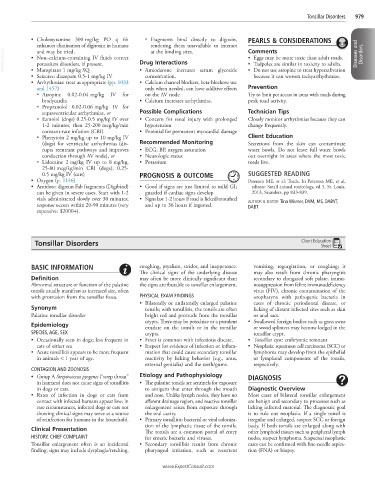Page 1958 - Cote clinical veterinary advisor dogs and cats 4th
P. 1958
Tonsillar Disorders 979
• Cholestyramine 300 mg/kg PO q 6h ○ Fragments bind directly to digoxin, PEARLS & CONSIDERATIONS
enhances elimination of digitoxin in humans rendering them unavailable to interact Comments
VetBooks.ir • Non–calcium-containing IV fluids correct Drug Interactions • Eggs may be more toxic than adult toads. Diseases and Disorders
at the binding sites.
and may be tried.
• Tadpoles are similar in toxicity to adults.
potassium disorders, if present.
• Maropitant 1 mg/kg SQ
concentration.
because it can worsen tachyarrhythmias.
• Seizures: diazepam 0.5-1 mg/kg IV • Amiodarone increases serum glycoside • Do not use atropine to treat hypersalivation
• Arrhythmias: treat as appropriate (pp. 1033 • Calcium channel blockers, beta-blockers: use
and 1457) only when needed, can have additive effects Prevention
○ Atropine 0.02-0.04 mg/kg IV for on the AV node Try to limit pet access in areas with toads during
bradycardia • Calcium increases arrhythmias. peak toad activity.
○ Propranolol 0.02-0.06 mg/kg IV for
supraventricular arrhythmias, or Possible Complications Technician Tips
○ Esmolol (dogs) 0.25-0.5 mg/kg IV over • Concern for renal injury with prolonged Closely monitor arrhythmias because they can
1-2 minutes, then 25-200 mcg/kg/min hypotension change frequently.
constant-rate infusion (CRI) • Potential for permanent myocardial damage
○ Phenytoin 2 mg/kg up to 10 mg/kg IV Client Education
(dogs) for ventricular arrhythmias (dis- Recommended Monitoring Secretions from the skin can contaminate
rupts reentrant pathways and improves • ECG, BP, oxygen saturation water bowls. Do not leave full water bowls
conduction through AV node), or • Neurologic status out overnight in areas where the most toxic
○ Lidocaine 2 mg/kg IV up to 8 mg/kg, • Potassium toads live.
25-80 mcg/kg/min CRI (dogs); 0.25-
0.5 mg/kg IV (cats) PROGNOSIS & OUTCOME SUGGESTED READING
• Oxygen (p. 1146) Peterson ME, et al: Toads. In Peterson ME, et al,
• Antidote: digoxin Fab fragments (Digibind) • Good if signs are just limited to mild GI; editors: Small animal toxicology, ed 3, St. Louis,
can be given in severe cases. Start with 1-2 guarded if cardiac signs develop 2013, Saunders, pp 833-839.
vials administered slowly over 30 minutes; • Signs last 1-2 hours if toad is licked/mouthed AUTHOR & EDITOR: Tina Wismer, DVM, MS, DABVT,
response occurs within 20-90 minutes (very and up to 36 hours if ingested. DABT
expensive: $2000+).
Tonsillar Disorders Client Education
Sheet
BASIC INFORMATION coughing, ptyalism, stridor, and inappetence. vomiting, regurgitation, or coughing; it
The clinical signs of the underlying disease may also result from chronic pharyngitis
Definition may often be more clinically significant than secondary to elongated soft palate, immu-
Abnormal structure or function of the palatine the signs attributable to tonsillar enlargement. nosuppression from feline immunodeficiency
tonsils usually manifests as increased size, often virus (FIV), chronic contamination of the
with protrusion from the tonsillar fossa. PHYSICAL EXAM FINDINGS oropharynx with pathogenic bacteria in
• Bilaterally or unilaterally enlarged palatine cases of chronic periodontal disease, or
Synonym tonsils; with tonsillitis, the tonsils are often licking of distant infected sites such as skin
Palatine tonsillar disorder bright red and protrude from the tonsillar or anal sacs.
crypts. There may be petechiae or a purulent • Swallowed foreign bodies such as grass awns
Epidemiology exudate on the tonsils or in the tonsillar or wood splinters may become lodged in the
SPECIES, AGE, SEX crypts. tonsillar crypt.
• Occasionally seen in dogs; less frequent in • Fever is common with infectious disease. • Tonsillar cyst: embryonic remnant
cats of either sex • Inspect for evidence of infection or inflam- • Neoplasia: squamous cell carcinoma (SCC) or
• Acute tonsillitis appears to be more frequent mation that could cause secondary tonsillar lymphoma may develop from the epithelial
in animals < 1 year of age. reactivity by licking behavior (e.g., anus, or lymphoid components of the tonsils,
external genitalia) and the teeth/gums. respectively.
CONTAGION AND ZOONOSIS
• Group A Streptococcus pyogenes (“strep throat” Etiology and Pathophysiology DIAGNOSIS
in humans) does not cause signs of tonsillitis • The palatine tonsils are sentinels for exposure
in dogs or cats. to antigens that enter through the mouth Diagnostic Overview
• Rates of infection in dogs or cats from and nose. Unlike lymph nodes, they have no Most cases of bilateral tonsillar enlargement
contact with infected humans appear low; in afferent drainage region, and reactive tonsillar are benign and secondary to processes such as
rare circumstances, infected dogs or cats not enlargement arises from exposure through licking infected material. The diagnostic goal
showing clinical signs may serve as a source the oral cavity. is to rule out neoplasia. If a single tonsil is
of reinfection for humans in the household. • Primary tonsillitis: bacterial or viral coloniza- irregular and enlarged, suspect SCC or foreign
tion of the lymphatic tissue of the tonsils. body. If both tonsils are enlarged along with
Clinical Presentation The tonsils are a common portal of entry other lymphoid tissues such as peripheral lymph
HISTORY, CHIEF COMPLAINT for enteric bacteria and viruses. nodes, suspect lymphoma. Suspected neoplastic
Tonsillar enlargement often is an incidental • Secondary tonsillitis results from chronic cases can be confirmed with fine-needle aspira-
finding; signs may include dysphagia/retching, pharyngeal irritation, such as recurrent tion (FNA) or biopsy.
www.ExpertConsult.com

